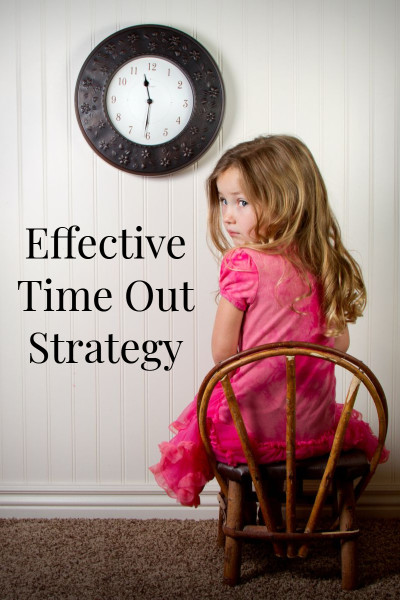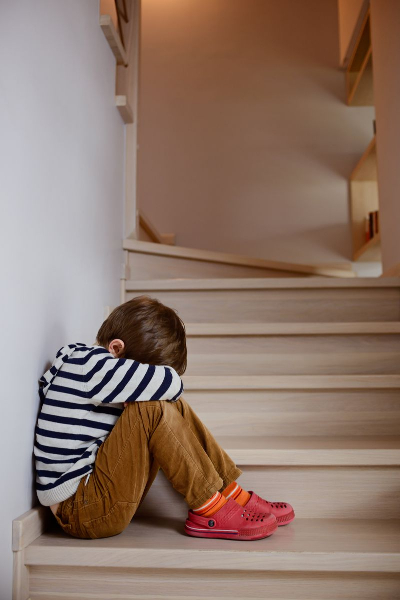A time-out for kids, when implemented early, correctly, and consistently is an extremely effective discipline strategy.
There is a lot of misinformation out there about the time-out for kids strategy and its effectiveness. Some people would even argue that time-out can be detrimental to a little one’s ego and development. I would argue differently. “Time out (for kids) (TO) is one of the few discipline strategies with empirical support and is recommended by the American Academy of Pediatrics.” (Drayton) It seems that the problem is in the implementation, not in the method itself. By reading this, you are already well on your way to learning the correct steps and saving yourself the headache of failed time-outs!

Trying to discipline our children can sometimes be a real challenge. We are tired, overworked, and stressed out. We worry constantly about our children and whether we are good parents! Patience is in SHORT supply. We are all human – it’s ok to admit it! Every single mom on the planet has lost their patience multiple times. You are not alone.
Families need a CONSISTENT, effective discipline strategy that everyone in the family can follow. In the majority of cases, this will bring your home so much peace…I promise. The keywords here though are consistent and effective.
A time-out is easy to do WRONG. Yes, you read that right. If you have already tried using time-outs as a discipline technique there is a good chance you have made mistakes. Again, you are not alone.
Worried? Don’t be. It’s not too late to get it right!
Let me reassure you. I have done a TON of research. Most things I implement in my own life I research as much as possible. I can’t help it! My training is in science and education, two incredibly research-heavy fields. I have summarized my findings for you here and I have also created a cheat sheet to help you implement a time-out correctly. Take your time to really understand the steps because remember, the biggest reason that time-outs don’t work is that they are not implemented correctly.
What is the appropriate age range to use time-out for kids?
Not for the littlest ones.
A time-out is not effective for very young children. A time-out should not be used on children under the age of 2. “Early toddlers are very susceptible to fears of abandonment and should not be kept in time-out away from the parent.” (CPS) They do not have the capacity yet to understand why they have been placed alone and it can be frightening thus doing more harm than good. It’s important to maintain the trust between child and parent.
Sometimes a parent becomes incredibly frustrated and needs to be away for a few minutes from their child under 2. This is ok! Place the cute little source of frustration in a safe place based on their age, (crib, pack-and-play or childproofed room) and take a few minutes away. This is far preferred over losing your cool and doing or saying something you will regret later! Take a few deep breaths and remind yourself that the child is not trying to upset you. They likely are bored or need something, even if only attention and a hug.
Age 2-3: Use your judgment
Children that are 2-3 years old are also not always ready for a time-out, although this varies based on the maturity and abilities of the individual. I know that I was able to use time-out with both of my kids when they were just over 2 years old. You will be the best judge if your child is ready yet. At this age, toddlers are prone to frustration because they want to be able to do everything (“Me do!!”), but can’t yet. They want independence (I can do it myself!) and can get angry when told no. As parents, we have to realize that this frustration comes from the child testing his/her abilities and not them being naughty or willfully disobedient.
The challenge for us as parents is to see the tantrums and outbursts for what they really are, the frustration of a little peanut in a big world. It’s scary! It’s overwhelming! We have to help our toddlers navigate these scary emotions with empathy and patience. A time-out is not right in these situations. There are plenty of options to help your child navigate these emotionally overwhelming situations. There are many situations, however, where a time-out is appropriate.
Age 3 and up: The perfect time!
You have to judge when is the best time to try a time out. You know your child the best! You will know if they are crying because they are frustrated or mad OR if they are crying because they are scared and deeply upset. The first scenario is fine, they can cry if they are frustrated. My kids do that during a time out but generally will settle down before the end of the timer. The second scenario is not good. We obviously do not want our children to be scared and it will also defeat the purpose of the time out. So again, use your judgment.
I will caution though, do not give up on the time out! Your kiddos will cry. They may hit the wall or kick things. They are mad and are showing it the only way they know how! We put them in a safe place for a reason. Let them vent and then when the time is up they will be ready to talk about it. I know it’s hard to listen to it and you will feel like your heart is breaking but keeping your kids safe and having children that will listen is worth it. The alternative may end up being unruly kids who end up being yelled at on a daily basis! Which is better, two minutes of temper tantrum or years of yelling?
For my kids, we rarely have to use time out because the warnings work so well! But they had to experience a few time outs first. It will get easier, I promise. Implement it correctly now while they are at the right age and it will pay dividends for years to come. But you must, must, must do it properly! Please!
How to properly use a time-out for kids:
Location:
Time-out does not need to have a specific place. It is about separating the child from the situation and from your attention. Have a safe place that you can have your child sit or stand and you are good. My kids sit in a corner at the end of the hallway or on a bottom stair. This can also be used outside, just find a safe place where you can stay close and see them at all times. This is about removing attention, not being out of sight completely.
I also recommend placing the child somewhat nearby. If you are downstairs in the family room, do not put them up in their bedroom. Just use an out of the way corner, or bottom of the stairs. Ideally, they shouldn’t be able to see you directly all of the time and should not be able to see a TV or other distraction. It is helpful if you can peak and see them without them noticing and you definitely need to be able to hear them.

How long:
How long should your child sit in time-out? Many experts recommend one minute per age of the child. However, this should be used as a guideline for the maximum amount of time your child should stay in time-out. Your 4-year-old child may only need 1 minute to regain control of their emotions and understand that what they did was wrong.
Give a warning:
Make sure that you give them a warning BEFORE using the time-out. After you have asked your child to do something or stop a certain behavior one or two times, this is when the warning should come. This is so important so that your child trusts that you will give them a warning and if they don’t heed your warning you will follow through with a time-out consequence. This is the real key to a time-out! They have to know that you will CONSISTENTLY follow through. You cannot give multiple threats and warnings.
If you are struggling with this, take a step back and think about why you are having a hard time. Do you feel bad about disciplining your child? Are you worried they won’t like you anymore? If you cannot implement this correctly, you will simply confuse and frustrate your child and it will only make their behavior worse (and no one wants that!)
Putting the child in time-out:
When your little love didn’t listen to your stern, single warning (only one warning!), now it’s time to place them in the time-out area. As you place them in the designated area, in a calm voice say something like: “Mommy is putting you in a time out because you (insert whatever behavior caused the time-out) and that is not allowed. You will sit here for (however many minutes is age-appropriate).” Then walk away. Do not look back at them or say anything else. If they try to get up, place them back in the spot without saying anything and walk away. Do this as many times as it takes for them to stay put. Then start the timer. Resist the urge to say anything! Trust me! It works.
Remember, there are always exceptions to the rule, but give it a shot before you assume your child just doesn’t respond to a time-out. If you have other children, make sure they don’t go over and talk to the lucky one in time-out. My daughter somehow knew she should stay away when her little brother earned himself a time-out, though she definitely wanted to go and see him.
During the time-out:
Do not engage with your child in any way once they are in the time-out. Remember, if they try to leave the designated spot, silently pick them up and put them back. Do not speak to them. I will even try to avoid eye contact and keep a calm facial expression. You may feel an overwhelming urge to go comfort your sweet trouble maker as they wail and cry and pound the floor. Resist that urge. I promise it will be ok. Your precious one will be ok and so will you. I know how hard it is, I have been there and know well the heart-wrenching feeling of listening to your child cry. In the end, this is helping them understand what consequences are, and setting you up for years of good listening.
After the time is up:
After the time is up and your child is calm it is important to end the time-out properly. Again, consistency is important!! Go and pick your child up and explain why they were placed in a time-out. Be very clear about this and use simple language. Use your child’s age and maturity as a guide for your explanation, but still, keep it simple. Use a calm and non-judgemental tone. This is not a conversation or a debate. Ask for an apology, and if the child cannot give you a sincere apology, they can be placed back in the time-out until they are ready to apologize. When the child does give you a sincere apology, tell them you love them very much, give them a big hug and kiss, and go on with your day.
If the reason that the child ended up in time-out requires some sort of clean up or fixing, talk to the child about how to fix the issue and let them follow through. Do not skip this step! The child must follow through with what you asked them to do, whether it is cleaning up a mess or apologizing to a sibling for hitting.
After everything is done, I usually try to do something interactive with them like playing a little game or build a tower with blocks. They need something to transition back to good behavior and to show that you are not upset or holding any grudge.

What parents should do:
It is important to let things go. You cannot stay angry or frustrated about the behavior after the time-out. Use the time-out as a time for you to take some deep breaths and remind yourself that your child is young and still learning how to behave properly. You are the role model. Show them how to remain calm. Show them how to handle big, difficult emotions without raising your voice or losing your cool. Remember, it’s not easy for you and it’s really not easy for them!
Use time-outs sparingly. This is not for minor offenses that can be dealt with in other ways.
Most importantly, remember that time-out is only one tool in your parenting toolbox. It is not a fix-all solution but only one strategy to be used.
When not to use a time-out:
Not every behavior is suitable to use a time-out for kids. If a child is having a true meltdown because they are overtired, overstimulated or hungry, a time-out will not be effective. This is when your child needs you to be comforting and empathize with what they are feeling. Simply saying to the child that you understand they are frustrated/tired/hungry/etc, you can begin to calm them down and help them regain control of their emotions.

What the research says:
As many of you know, my background is in science, medicine, and education. I always do my best to find reliable sources of information for every article that I write. It is so important these days to do this! There is a lot of misinformation out there. It can also be hard to keep up with the latest research.
Time-out for kids as a disciplinary strategy has been researched and has evidence to support its effectiveness. The biggest problem though that comes up in the research is the misinformation and mistakes that parents make in implementing this technique. One research article published in 2015 (https://www.ncbi.nlm.nih.gov/pmc/articles/PMC4179870/) states that:
“A parent searching for information about TO (time-out) on the Internet will find largely incomplete, inaccurate, and inconsistent information. Since nonadherence to any 1 parameter will decrease the efficacy of TO, it is not recommended that pediatricians suggest the Internet as a resource.”
The results of this research showed not one website that was analyzed was fully correct. They were all missing something important to the time-out protocol. About 30% of the websites also incorrectly claimed that time-out was ineffective.
“None of the pages reviewed included accurate information about all empirically supported TO parameters. Only 1 parameter was accurately recommended by a majority of webpages. Inconsistent information was found within 29% of the pages. The use of TO to decrease problem behavior was inaccurately portrayed as possibly or wholly ineffective on 30% of webpages.”
Another journal article (https://www.ncbi.nlm.nih.gov/pmc/articles/PMC2719514/) discusses the importance of consistency and being on the same page for both parents and any other caregivers.
“One of the major obstacles to achieving these goals is inconsistency, which will confuse any child, regardless of developmental age. It can be particularly hard for parents to be consistent role models. Telling children to “Do as I say, but not as I do” does not achieve effective discipline. Parental disagreements about child-rearing techniques, as well as cultural differences between parents, often result in inconsistent disciplining methods.”
It all comes down to…
Parenting a toddler (and just kids in general) is hard folks. It’s ok to admit that. Time-out for kids is one strategy in a large toolbox to help you teach your child good behavior. You might be blessed with the most easy-going, adaptable toddler or you may have the most rambunctious, hard to please, freak out over everything kid. You know your child. Pay attention to what sets them off. A good majority of behavior problems with children of all ages is from boredom! I see it in my own toddlers and I see it in the high school students I teach. If they are bored, bad things start happening.
Be mindful.
Life is full of things to do, emails to read, dishes in the sink, laundry piled up, and on and on. However, having children is the biggest, most important job you will ever have. It’s your legacy. Put in the effort now when they are little and you will be thankful you did. Ask the parent of an unruly pre-teen or teenager. Chances are they wish they could go back and do things differently. Don’t be too distracted or too busy to parent your children. It’s not about being perfect all the time! It is about being present. Schedule time that is just for you, that is definitely important. BUT, when you are with your kids, be with them fully.
On the fence?
Don’t think this would work for your kid? Give it a try. Be fully committed to doing the steps correctly and try it for a couple of months. If at that point it doesn’t seem to be helping, try another strategy. I truly believe though, if implemented correctly and consistently (notice the theme), a time-out will be effective for nearly all children.
A time-out for kids is a great tool to start discipline right in your toddler but it is important to do it right. By following the steps outlined in this article you will be well on your way to consistent discipline that doesn’t require battles, threatening or yelling. A simple warning and a follow-through time-out are all you need. Try it! You will be glad you did. It worked wonders for our children and I truly hope the same for your family.
Have any questions? I am here for you! Leave your question in the comments and I will answer! You can also help make this post better so please, leave your thoughts and suggestions!
You can also reach out via email, Facebook or Instagram!
References:
- Drayton, A.K. et al. Internet Guidance on Time Out: Inaccuracies, Omissions, and What to Tell Parents Instead. Journal of Developmental and Behavioral Pediatrics. May 2014; 35(4): 239-246. https://www.ncbi.nlm.nih.gov/pmc/articles/PMC4179870/
- Paediatrics Committee. Effective Discipline for Children. Paediatrics and Child Health. January 2004; 9(1): 37-41. https://www.ncbi.nlm.nih.gov/pmc/articles/PMC2719514/
- Batcha, B. Why time-out is out. Parent magazine: No date found. https://www.parents.com/toddlers-preschoolers/discipline/time-out/why-time-out-is-out/
- Martinelli, K. “Are time-outs harmful to children?” Child Mind Institute. No date found. https://childmind.org/article/are-time-outs-harmful-kids/


Leave a Reply